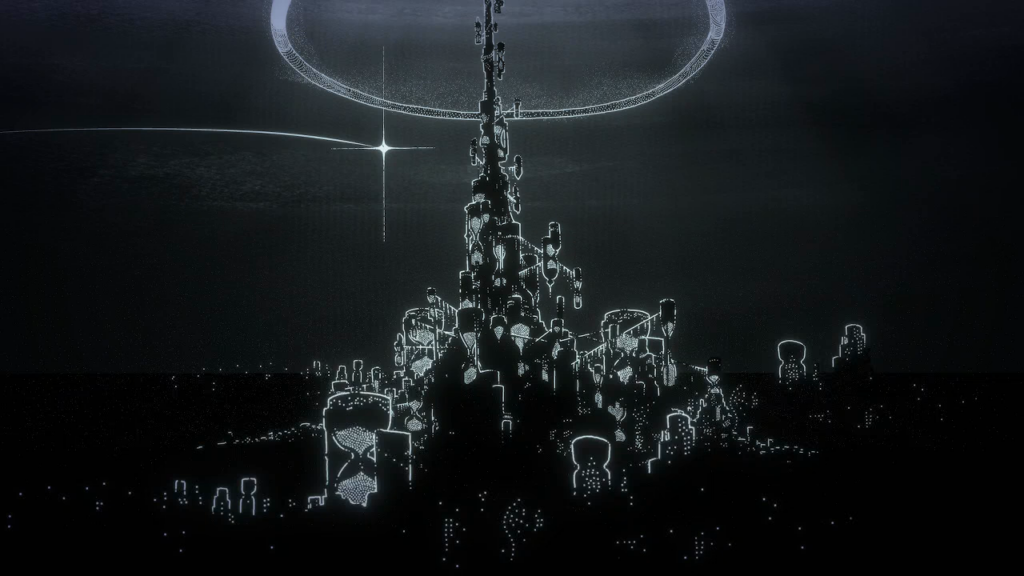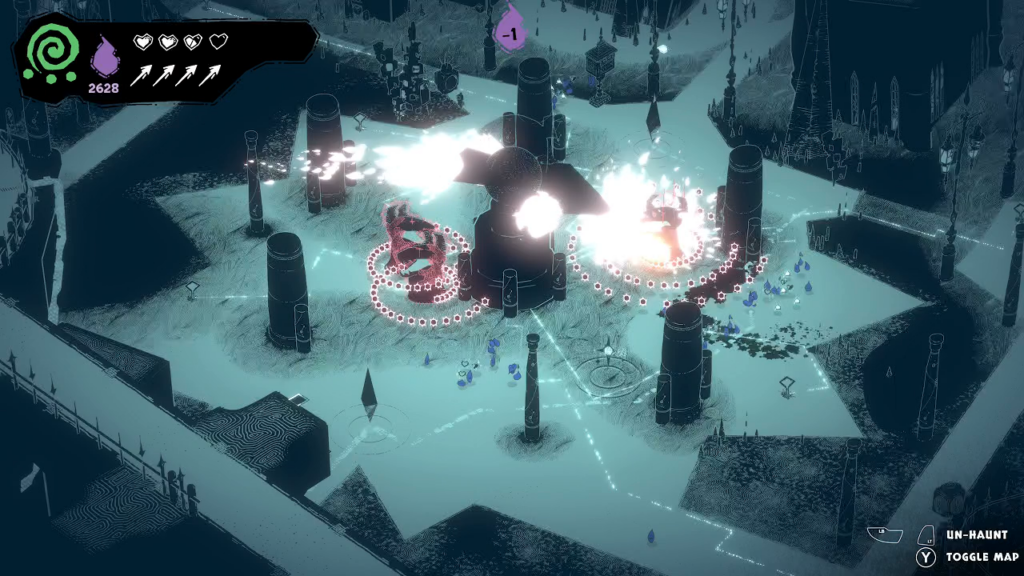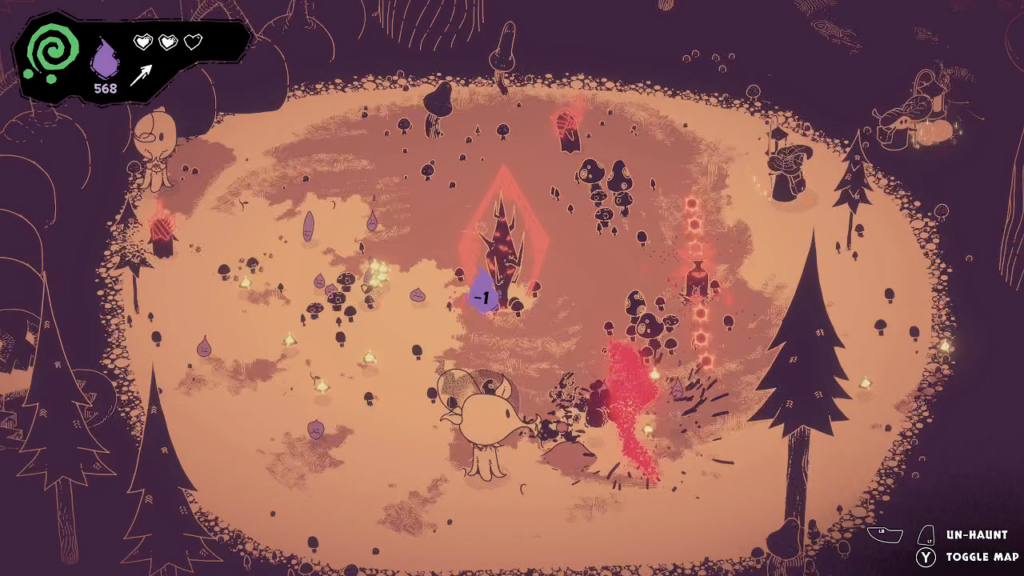Hauntii is a level-based puzzle videogame set in Eternity, an afterlife where ghosts in a world of darkness live frivolous and fearful lives under the judgmental watch of the Eternians, angels who live in a sky of light. I play as a new ghost who is rescued by an Eternian from a monster lurking in the deepest parts of the darkness. When the Eternian tries to carry the player character into the light, they are pulled back into the darkness by black chains. To break these bonds, the player character must search Eternity for lost stars which illuminate the forgotten memories of their former life. Only by recovering and casting off these memories can they ascend with their guardian angel from the darkness into the light, reminded by other ghosts at every turn that the Eternians cannot be trusted.

Eternity is a beautiful hand drawn world of contrasting light and darkness. Each of its several dozen levels is represented with a distinct monochromatic palette that gives them a unique color identity while maintaining an interplay of light and darkness. The Mushroom Spirit Wood sets its black space against a shade of brown like parchment, suggesting the musty, decaying atmosphere of an old growth forest choked by mushrooms. The ghost theme park Wickland contrasts its darkness with a friendly, rosy red that grows muted as the player character nears the peak of its oldest and most treacherous attraction. The Void is a desert-like region where the darkness is almost overpowered by wastelands of golden sand that glistens so brightly it almost appears like the pure, Eternian white. I can recognize where the player character stands anywhere in Eternity solely by looking at the surrounding color palette.
Stars are a recurring idea across Hauntii and they appear both subtly and overtly in its visual design. Immediately I recognize that many of the spaces where light and darkness meet are marked by speckled patterns of light that grow less and less dense as the darkness overwhelms the space. It isn’t until the player character visits a representation of a night sky that I recognize these specks of light as having a star-like quality. It’s as though Eternity is created by starlight.

I only wish this motif was followed consistently throughout. While the idea of clustered stars is prominent in every area, just as many objects are drawn by smooth, uniform lines. As much as I love Hauntii visually, I would love it even more if I could squint at its finer details and see that the trees in the Wood, the parade balloons in Wickland, and the ancient ruins of The Void were all formed by innumerable and minute points of light instead of solid lines.
The player character’s paths through Eternity’s dark vacuums are marked by zig-zagging, swirling, and looping roads of light. When they wander off these roads, the screen distorts, an ominous drone overwhelms the soundscape, and evil eyes begin to peer out of the darkness. These effects grow to a crescendo until the screen collapses into blackness, the sound explodes into silence, and the player character appears back in a patch of light missing a valuable hit point. These effects symbolize the monster that waits in the darkness to prey upon ghosts who stray from the light.

Much of the intrigue in Hauntii’s levels is thoroughly exploring them without succumbing to this monster. Paths of light lead to many of the most important areas. The collectables the player character needs to unshackle themselves from the darkness are often hidden away from these safe paths, deep in areas where light and dark intermingle, or even in places where darkness is absolute. The safety afforded by the light is also the player character’s clearest indication that other ghosts’ frequent warnings about the Eternians are not totally informed or unbiased ones.
While the juxtaposition of light and darkness is often wonderful to look at, as environments become more complex and more vertical, the sheer amount of darkness can make spaces difficult to read. After guiding the player character to the top of a cliff or tower, I can see a hollow extending in all directions. Is that hollow the side of the spire they stand atop? Or is it a space that may be walked through, potentially hiding an oasis of light somewhere far offscreen? Often the only way to tell is to step into that hollow and see if the player character falls harmlessly to the ground below or stands firm on an unknowable floor. These unclear vertical perspectives don’t occur often enough to make Eternity frustrating to explore. They do occur often enough to feel worth mentioning and they become more frequent as the player character nears their goal.

Most of the ghosts that wander Eternity are not inherently dangerous. Many are unhelpful and have malevolent intentions for any Eternians they may encounter but few are actively hostile. The dangerous ghosts the player character does encounter are marked by Hauntii’s few flourishes of color, their bodies enveloped in an orange or red aura representing a corrupting evil. When they spot the player character, they attack with a combination of melee collision damage and fast-moving projectile attacks.
Avoiding these attacks isn’t easy. The player character does not move quickly. Their ambling walking speed is augmented by a dash that sends them darting a short distance forward. This dash needs a moment to refresh before it may be used again so large groups of enemies can still become overwhelming. To counterattack, the player character can shoot a barrage of energy using twin-stick shooting controls. Sustained fire exhausts this ability and, like the dash, takes a moment to refresh. These cooldowns built into the player character’s abilities demand patience when fighting hostile ghosts. Aggressive play is a good way to get the player character drained of their limited life meter and sent back to the last save point.

The player character’s other main ability is to haunt objects and creatures. Eternity is rife with vessels for the player character to inhabit and their abilities have applications both in combat and out. Some are explicitly sentient beings occupying some definition of “life,” like ladybugs that crawl up and down the side of evergreen trees in the Mushroom Spirit Wood and firework-launching carnival workers in Wickland. More mundane objects can also be haunted with unexpected results. Haunting the scales of Wickland’s Test Your Might minigames sends the player character flying high into the air when they are struck by a hammerswing. Towering obelisks can be compelled to fall over, potentially onto especially dangerous hostile ghosts. Learning what in Eternity may be haunted and experimenting with their effects is where much of Hauntii’s puzzle solving lies.
As the player character explores Eternity they collect frowning purple spirits called ghost flames. They appear almost everywhere, scattered along paths of light and dropping from vanquished hostile ghosts. Ghost flames are required to use some of the haunted forms’ most powerful abilities. Each time the possessed carnival worker fires a firework or a flower spits a projectile from its snout, it costs a ghost flame.

Ghost flames appear with such frequency they may as well not exist. The player character always has dozens, if not hundreds of them at any time. When I reach Hauntii’s conclusion, the player character is at their carrying cap. Ghost flames serve no impactful function, but by that same judgment they have no impact on my experience. The player character always has more than they need to use their haunted forms’ abilities. They’re a meaningless addition which may be ignored as long as, paradoxically, I don’t ignore collecting them.
The player character’s main goal while exploring Eternity is to discover stars which have fallen from the sky. By visiting altars that appear every few levels, they may stargaze and return recovered stars to their missing spots in constellations. Completing constellations has two effects. Each one completed lets the player character add extra hit points or charges to their dash and firing abilities. More significantly to the narrative, the shapes of revealed constellations reignite forgotten memories of the player character’s former life.

The people in these memories are depicted as featureless white blobs. This obscures their identities but does nothing to hide the meaning of their actions and the feelings they spark in the player character’s living self. A teacher catches them folding an origami boat instead of doing an assignment and tears it up to the cruel laughter of the rest of the class. During a trip to an aquarium, they gaze in awe at a passing whale. At a random moment, for no reason at all, their thoughts are overwhelmed by a riot of spiraling lines and spinning circles, reducing them to a huddle of trembling anxiety. The memories capture a complete life, of sadness and wonder, of success and failure, of comfort and distress. They are Hauntii at its most artistic and moving.
Completing constellations and recovering their forgotten memories are how the player character is able to break the chains that shackle them to the world of darkness. Each of Hauntii’s four regions has a different collection of constellations to complete. Revealing enough constellations solidifies them into a jewel which the player character can sacrifice to break one of the chains, essentially trading what remains of their past life for a new one in the land of light. The philosophical implications of this are many and Hauntii is bravely vague about what it is really saying about death, life, rebirth, and moving on from the past.

A handful of the stars the player character needs are found out in the open as mile markers on the player character’s trudge to the end of the narrative. There are not nearly enough of these to finish all the required constellations. The rest require the player character to solve puzzles in each area utilizing all the player character’s abilities.
The best puzzles require the player character to haunt something in a level and use it in a unique way. In Wickland, frowning orbs can expand or retract their arms to move the roller coaster tracks they support above their heads, allowing its cars to pass through rings that reveal a star. Sandwhales swim through The Void like water and may be haunted to compete in races or to ram a flying ship piloted by a homicidal mad scientist. I am allowed to see how many stars are still hidden in a level but I am given no clues of what actions may reveal them. Finding the single hauntable vessel in an area and finding the unexpected and sometimes inexplicable way it must be used to reveal a star is Hauntii at its most creative, challenging, and frustrating.

The majority of puzzles have much more mundane solutions which repeat themselves in slightly different permutations across the many levels. Orbs representing the phases of the moon are scattered across the level; collect them all to reveal a star. Rings of light mark a tricky path through the environment; run through them all in a tight time limit to reveal a star. A particular area contains a large number of corrupted ghosts; defeat them all, often with the help from a nearby hauntable object, to reveal a star. I am sympathetic to the necessity of some rote design mechanization to fill even a small videogame but I cannot quell a sensation that Hauntii begins repeating itself quickly. Collecting these stars feels repetitive.
The number of stars found in each level is inconsistent. Most contain three to six stars, a manageable number that balances a sense of satisfaction through exploration against satisfaction with forward momentum. Some levels contain far more. Wickland’s Grand Carousel contains a whopping thirteen stars, enough to fill in at least two constellations. Rooting out the final two or three stars while walking repeatedly back and forth across its huge area becomes dispiriting.

Equally as dispiriting is trying to return to a previous area to collect stars I missed. Hauntii does not have a proper fast travel system until the player character reaches the threshold to the ending. Even then, its fast travel system is limited, leading to just six levels of several dozen. Backtracking to a previous level to search for missed stars involves slogging across many other levels, getting lost on the way there, backtracking again, finally finding the right level, still having no clue where the missed star is hidden, and giving up in frustration.
Finishing Hauntii is straightforward. It has far more hidden stars than are required to complete the empty constellations needed to see its ending. One hundred percent completing Hauntii is another matter entirely. It is a chore that tests my patience and challenges my appreciation for Hauntii’s artistic craft.

I admire Hauntii for its bold monochromatic visuals which lead directly into its themes about life and death. These elements do much of the work in elevating bland and repetitive puzzle solving. A few of Hauntii’s puzzles requiring the unexpected and imaginative use of a haunted object or individual stand out. The rest of its puzzles are repetitive and trite, tasking the player character with completing challenges that are familiar even before they begin repeating themselves across Eternity. Hauntii feels like a dessert extravagantly decorated with fondant; it’s nice to look at and it may contain a few delicious bites, but beneath its beauty it has a tasteless and unappealing texture. I enjoy looking at it more than playing it.